Zonnevlek 2529 is groter dan de aarde
Op dit moment produceert hij enkel c klasse zonnevlammen, maar zou in staat moeten zijn om een M klasse zonnevlam te produceren in de komende 24-48 uur.
The sun's headlong plunge into solar minimum has been interrupted by the surprise emergence of a big sunspot. AR2529 doubled in size over the weekend, and the behemoth spot is now being photographed by amateur astronomers around the world. On Saturday, Jean-Pierre Brahic of Uzès, France, took this picture of the swirling maelstrom of magnetic fields at the sunspot's dark core:
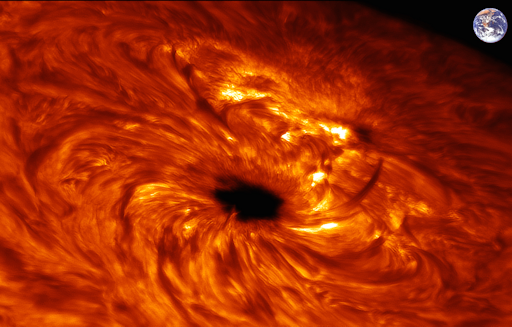
As the inset image of Earth shows, the sunspot's core is wide enough to swallow our planet--twice. Fortunately we are 93 million miles away.
NASA's Solar Dynamics Observatory (SDO) is keeping a close eye on this active region. Magnetic fields near the sunspot's core are crackling with minor C-classsolar flares. None of these flares are very strong, but the ensemble of explosions is doing a good job heating the sun's atmosphere above the sunspot. The towering "hot spot" is shown in this extreme ultraviolet image taken by SDO on April 10th:
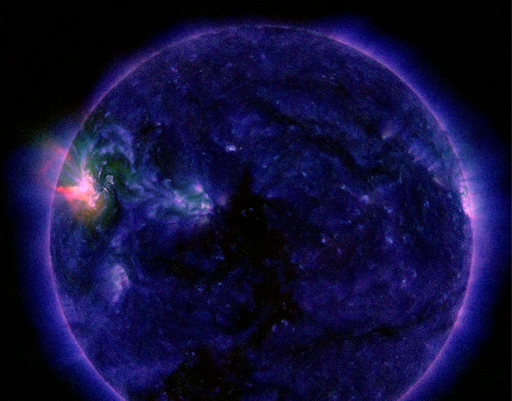
Despite its large size and state of unrest, AR2529 has not yet launched a significant solar storm. C-class flares are considered to be small. Stronger flares may be in the offing, however, if the sunspot continues to grow in the days ahead. Stay tuned.
Bron:http://www.spaceweather.com/
Morgen 75% kans op een G1 geomagnetische storm, gevolg aurora's
NOAA forecasters say there is a 75% chance of G1-class geomagnetic storms on April 13th when a solar wind stream is expected to hit Earth's magnetic field. High-latitude sky watchers should be alert for auroras.
The incoming solar wind stream is pouring out of a hole in the sun's atmosphere--a "coronal hole"--shown in this image from NASA's Solar Dynamics Observatory:
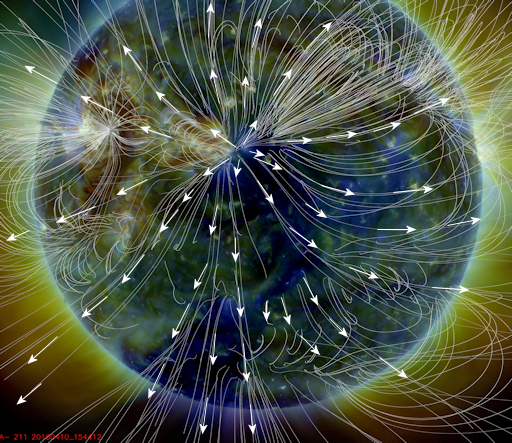
Coronal holes are places in the sun's upper atmosphere where the magnetic field peels back and allows solar wind to escape. In the image, above, the sun's magnetic field is traced by pale arcing lines. Arrows indicate the flow of solar wind.
All solar wind streams carry some of the sun's magnetic field into space. The stream now heading for Earth appears to be filled with "negative polarity" magnetic fields. Such fields can easily link to Earth's magnetic field, opening a crack in our planet's defenses against solar wind. As a result, this solar wind stream could be effective at sparking auroras
Bron: http://www.spaceweather.com/
Nu live aurora borealis via webcam Yellowknife
Zoals gisteren gemeld was het wachten op de aankomst van de G1 klasse geomagnetische storm. Hij is er...geniet mee!Negative magnetic fields spark auroras
For the past three days Earth has been passing through a region of interplanetary space filled with negative-polarity magnetic fields. This has caused intermittent geomagnetic storms and beautiful auroras around both poles. On May 2nd, Svante Sandström photographed this display over Västerlanda, Sweden:
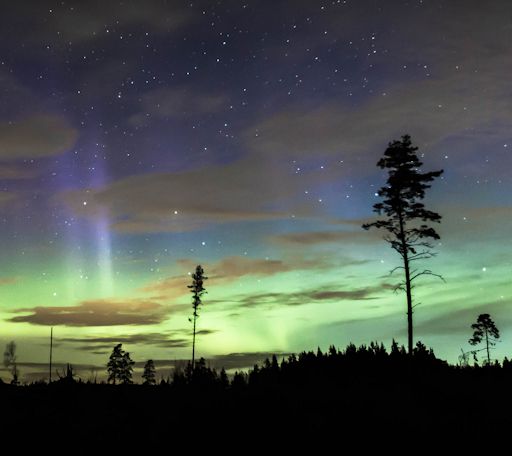
photo Svante Sandström
The auroras and their movements were absolutely stunning," says Sandström.
"This could be the last performance of the season at our latitude," he adds. "Summer is coming, and the night skies are growing too bright for auroras."
Earth entered this aurora-friendly region of space on Saturday, April 30th, when we crossed through a fold in the heliospheric current sheet. Many people have never heard of the heliospheric current sheet. It is one of the biggest things in the solar system--a vast undulating system of electrical currents shaped like the skirt of a ballerina: picture. Earth dips in and out of it all the time. Currently, we are on the side of the current sheet containing negative-polarity magnetic fields. Such fields can open a crack in our planet's magnetosphere, allowing solar wind to pour in and fuel colorful displays.
During the current episode, Northern Lights have descended as far south asMichigan, while Southern Lights have ascended as far north as New Zealand. NOAA forecasters estimate a 25% chance of more storms tonight.
Bron: http://www.spaceweather.com/ | Gewijzigd: 31 januari 2017, 15:31 uur, door Joyce.s
Een combinatie van Aurora's en lichtende nachtwolken:
Who needs sunspots? Despite a sudden lull in solar activity, July began with a beautiful display of color over Calgary, Alberta. Harlan Thomas photographed the sudden apparition of green auroras and silver noctilucent clouds:
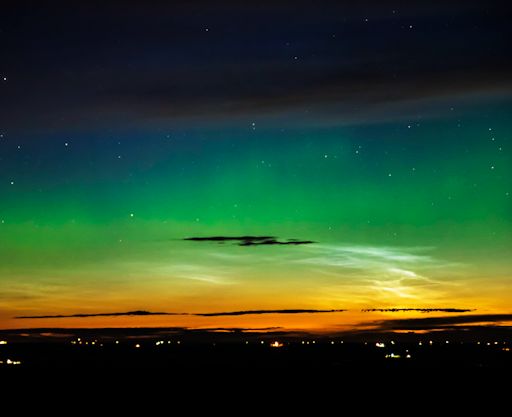
photo . Harlan Thomas
On the evening of June 30th, I faithfully checked the Spaceweather.com AIM daisyand saw that noctilucent clouds were forming over North America," says Thomas. "So I drove my Jeep to a dark location outside Calgary--and promptly fell asleep."
"About 30 minutes after midnight on July 1st something woke me up," he adds. "The noctilucent clouds had appeared, and they were not alone. I was surprised to see some green auroras as well."
Indeed, the auroras were a surprise. There were no sunspots, no solar flares, and no CMEs on June 30th, yet skies turned green anyway. Here's what happened: Earth passed through a region of space filled with negative-polarity magnetic fields (known to researchers as "negative B sub z"). Such fields can open a crack in Earth's magnetosphere. Solar wind pours in and sparks auroras--no sunspots required.
At the same time, an even brighter display of auroras appeared over Antarctica.
Bron: http://www.spaceweather.com/ | Gewijzigd: 31 januari 2017, 15:32 uur, door Joyce.s
Wie dacht dat er enkel poollicht op Aarde voorkomt heeft het goed mis, op de planeet Jupiter is er af en toe ook poollicht te zien, maar niet door de zon! Met behulp van de Hubble ruimtetelescoop is men tot de conclusie gekomen dat de maan Io van Jupiter geladen deeltjes van de vulkanen de ruimte inspuwt. Io straalt geladen deeltjes uit van de vulkanische activiteit langsheen een onzichtbare stroom van geladen deeltjes die een 'fluxbuis' wordt genoemd. De deeltjes volgen dan het magnetisch veld van Jupiter naar de polen. Daar komen ze in aanraking met de atmosfeer en veroorzaken daar het poollicht.

Beelden van de Hubble ruimtetelescoop
Bron:
http://www.wetteronline.de/astronews/2016-07-04-ju
https://www.spacepage.be/artikelen/het-zonnestelsel/de-planeten/jupiter/poollicht-op-jupiter
Coronaal gat 700.000 km lang !
De zonnedeeltjes zullen 8 a 9 juli de aarde bereiken, gevolg aurora's.
A canyon-shaped hole has opened up in the sun's atmosphere, and it is spewing solar wind into space. NASA's Solar Dynamics Observatory is monitoring the structure, which stretches more than 700,000 km from end to end:
This is called a "coronal hole." Coronal holes are places in the sun's atmosphere where magnetic fields peel back and allow hot gas to escape. A gaseous stream of solar wind flowing from this opening will reach Earth on July 8th or 9th, possibly sparking polar geomagnetic storms when it arrives. High-latitude sky watchers should be alert for auroras, especially in the southern hemisphere where dark winter skies favor visibility.
Bron: http://www.spaceweather.com/
| Gewijzigd: 6 juli 2016, 13:12 uur, door Joyce.s
Een G1 Klasse storm
Het resultaat van de zonnedeeltjes, afkomstig van het enorme coronale gat heeft tot dusverre geleid tot een G1 klasse storm. Dit houdt in dat er een kleine impact op onze satellieten kan zijn, migrerende dieren (die hun coördinaten bepalen m.b.v. het magnetische veld) er hinder van kunnen ondervinden; en er fluctuaties op het stroomnetwerk kunnen ontstaan. Tevens is het noorder- en zuiderlicht zichtbaar.
Hieronder enkele gegevens tot nu toe:
De Kp-index is niet boven de 5 uitgekomen:

http://services.swpc.noaa.gov/images/planetary-k-index.gif?time=1467959402000
Er zijn geen grote uitschieters w.b de snelheid, dichtheid en temperatuur van de deeltjes;
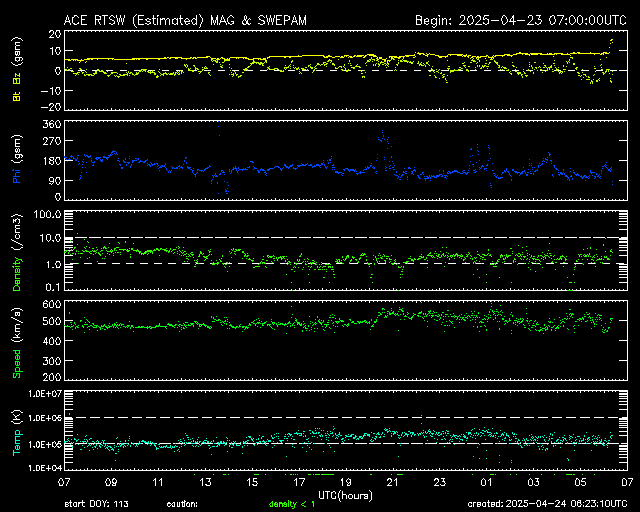
http://services.swpc.noaa.gov/images/ace-mag-swepam-24-hour.gif
Er is wel plasma- penetratie (rode lijn komt boven de blauwe uit);

http://services.swpc.noaa.gov/images/goes-magnetometer.gif
En derhalve ook aurora borealis zichtbaar:
Noordpool:
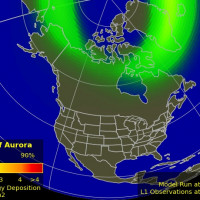
http://www.spaceweather.com/POES/pics/usa_thumb.jpg
Zuidpool:
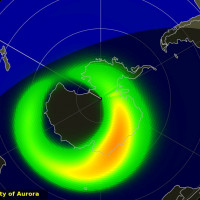
http://www.spaceweather.com/POES/pics/antarctica_thumb.jpg
Helaas zijn de meeste webcams om het noorderlicht in de gaten te houden c.q bewonderen tot augustus offline, maar de National Science Foundation (NSF) op Antarctica hebben wel hun webcam online staan:
Amundsen-Scott South Pole Station Camera
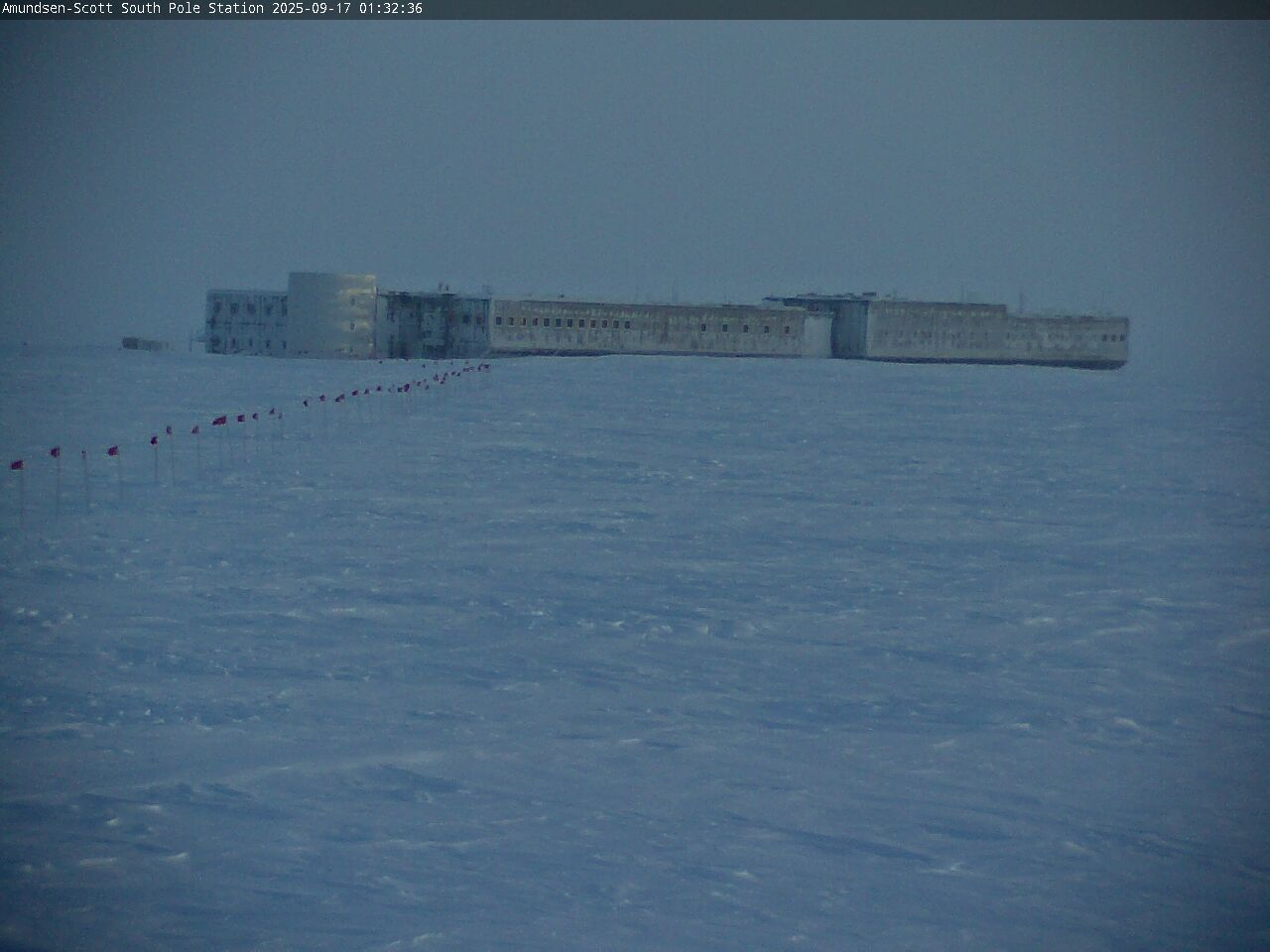
http://www.usap.gov/videoclipsandmaps/spwebcam.cfm
Voor de "livebeelden" ga naar bovenstaande link.
Tot zover deze update.
| Gewijzigd: 8 juli 2016, 10:27 uur, door Joyce.s
Ook vandaag kans op een G1 klasse zonnestorm.
aurorawatch geldt voor de komende 48-72 uur.
We blikken even kort terug op het afgelopen weekend.
We hadden bijna een M-klasse flare te pakken, maar hij bleef steken op een C 8.6.

http://solarham.net/pictures/archive/jul10_2016_c8.jpg

http://services.swpc.noaa.gov/images/goes-xray-flux.gif
Het enorme coronale gat zal de komende 48-72 uur voor zonnewinden zorgen die bij ons aurora's als resultaat geven.

Ook vandaag is er weer kans op een G1 klasse zonnestorm, Kp-index: 5.
Status op dit moment (vooralsnog gemiddelde waarden):
Snelheid: 528.6 km/sec
dichtheid: 2.2 protons/cm3

http://services.swpc.noaa.gov/images/ace-mag-swepam-24-hour.gif
Aurora's op dit moment:


http://www.spaceweather.com/
Een zonnevlekgroep om in de gaten te houden is zonnevlek nummer 2564:

http://solarham.net/pictures/regions2.jpg
De positieve en negatieve umbra (in afbeelding rode en blauwe gebieden), staan op het punt van interactie. Dit kan zonnevlammen (met cme) als resultaat geven. Is hij op dat moment aardegericht, dan zien we dat ook hier bij ons op aarde weer terug.
Tot zover deze update.
4 M- klasse zonnevlammen achter elkaar
Region 2567 is going out with a bang. Three moderately strong solar flares were observed early Saturday morning around the departing region. The first was an M5.0 at 02:11 UTC (July 23). The second event, a strong M7.6 at 05:16 UTC, was quickly followed up by an impressive M5.5 event at 05:31 UTC. The third event (M5.5) was associated with a 10cm Radio Burst, Type II and IV radio emissions, and a coronal mass ejection (CME) that appears to be directed away from our planet. Other than the brief radio blackouts at the time of the flaring, no major impacts to our planet is to be expected. Stay tuned to SolarHam.com for the latest information.
Bron: http://solarham.net/pictures/archive/jul23_2016_m7.6.jpg

http://services.swpc.noaa.gov/images/goes-xray-flux.gif
Impact op aarde:

http://services.swpc.noaa.gov/images/planetary-k-index.gif
De vlammen waren niet aarde gericht. Desondanks toch een G1 klasse zonnestorm:
HOW A CME CAN MISS EARTH AND STILL CAUSE A GEOMAGNETC STORM: A cluster of coronal mass ejections (CMEs) hurled into space by the strong flares of July 23rd will not hit Earth. They might spark a geomagnetic storm anyway. Scroll past the movie for reasons why.
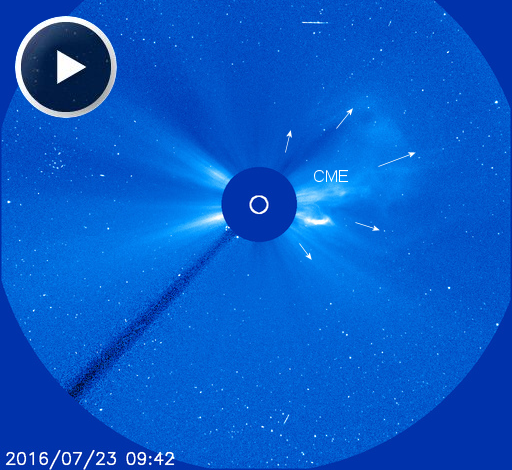
Computer modeling by NOAA analysts suggest that the body of the combo-CME will sail wide of Earth. However, shock waves in the solar wind billowing away from the CME's outskirts might deliver a glancing blow to our planet's magnetic field. ETA: July 26th, the same day a solar wind stream is due to reach Earth. There is a 45% chance of G1-class geomagnetic storms in response to the shock waves + solar wind. High-latitude sky watchers should be alert for auroras on Tuesday night, especially in the southern hemisphere where dark winter skies favor visibility.
Bron: http://www.spaceweather.com/
Zuiderlicht
A minor stream of solar wind is buffeting Earth's magnetic field. On July 25th, it caused a beautiful display of southern lights over New Zealand. "It was exciting to see such strong activity," says Taichi Nakamura who sends this picture from Dunedin on the South Island: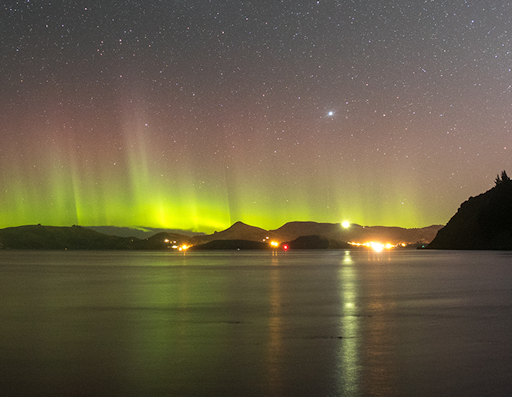
photo Taichi Nakamura
"Aurora kept rolling through, flowing from left to right following Earth's rotation," says Nakamura.
How did such a minor stream of solar wind produce such beautiful lights? It had help. Magnetic fields in the interplanetary space tilted south and linked up with Earth's magnetic field. This opened a crack in our planet's magnetosphere. Solar wind poured in to fuel the display.
CHANCE OF STORMS TODAY:
NOAA forecasters say there is a 45% chance ofG1-class geomagnetic storms on July 26th when a high speed stream of solar wind is expected to hit Earth's magnetic field. The outskirts of a CME might deliver a glancing blow at about the same time. High-latitude sky watchers should be alert for auroras.
Bron: http://www.spaceweather.com/ | Gewijzigd: 31 januari 2017, 15:33 uur, door Joyce.s
The whole landscape turned green:
A high speed solar wind stream hit Earth's magnetic field on July 28th, and is still blowing around our planet now. The effect in Manitoba, Canada, was to turn the whole landscape green: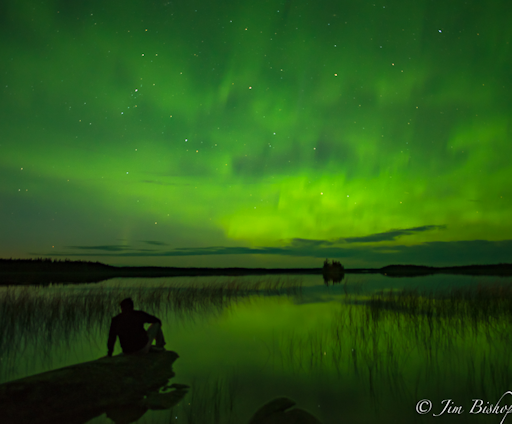
"Auroras were covering most of the sky, and we had a calm wind," says photographer Jim Bishop. "I was able to set up my tripod and dash into the shot for a self-portrait."
Earth's magnetic field should remain active and glowing on July 29th. NOAA forecasters estimate a 35% chance of G1-class geomagnetic storms around both poles as the solar wind continues to blow.
Bron: http://www.spaceweather.com/
As northern summer comes to an end, the midnight sun is setting around the Arctic circle. However, night skies aren't turning black. They're turning green. Alexander Kuznetsov photographed the phenomenon from the Finnish Lapland on Aug. 30th:
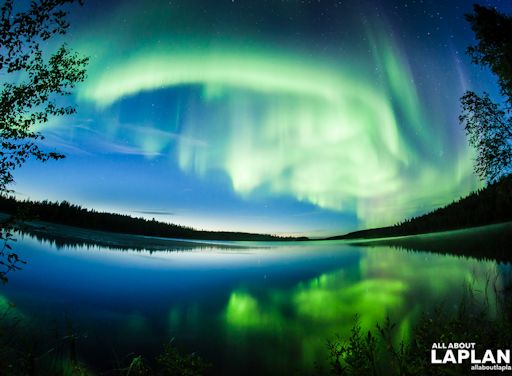
photo Alexander Kuznetsov
The outburst of green did not last too long, maybe 15 min, but it surely was very powerful and beautiful," says Kuznetsov. "Certainly one of the best auroras I've ever seen--and I've seen many."
The display was caused by a patch of south-pointing magnetic fields in the solar wind. Those fields connected to Earth's magnetic field, opening a crack. Solar wind poured in to fuel the lights. A similar outburst was observed over the South Pole.
More lights could be in the offing on Aug. 30-31 as a new solar wind stream approaches Earth.
Bron: http://www.spaceweather.com/ | Gewijzigd: 31 januari 2017, 15:34 uur, door Joyce.s
Prachtige aurora's afgelopen weekend
Around the Arctic Circle, the end of summer is greeted with mixed feelings. The midnight sun sets, taking its cheerful rays below the horizon. The air might not be warm again for months. The onset of cold, however, brings something wonderful to behold. This:
photo Kristin Berg
"A new season with Northern Lights has started in northern Norway," reports photographer Kristin Berg, who took this picture on Sept. 2nd from Tromsø. "What a night! "
Northern Lights are returning to the Arctic for two reasons. The first is simple: It's getting dark. The exit of the midnight sun is leaving velvety-dark skies where geomagnetic storms can paint their colors. The second is a little more complicated. During the weeks around equinoxes, the tilt of the interplanetary magnetic field favors geomagnetic storms. Even gentle gusts of solar wind can spark bright outbursts of light.
Aurora season has definitely begun.
Bron:http://www.spaceweather.com/ | Gewijzigd: 31 januari 2017, 15:34 uur, door Joyce.s
Filament op de zon 450.000 km lang
A dark filament of magnetism is snaking across the sun today. Measuring more than 450,000 km from end-to-end, the bushy structure is an easy target for properly filtered backyard telescopes. Amateur astronomer Mike Taormina sends this picture from Malta, New York: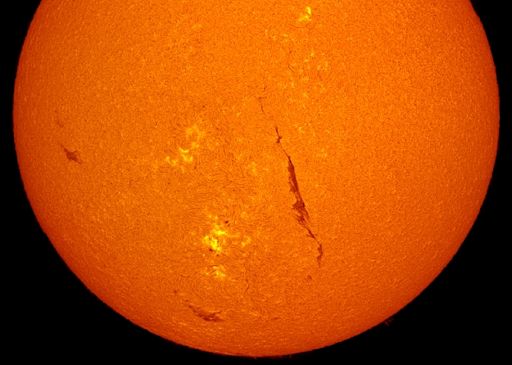
The filament is filled with plasma held above the surface of the sun by magnetic lines of force. Structures like this one tend to be unstable. If the filament collapses, it could fall to the surface below, igniting an explosion called a 'Hyder flare." The blast, if it occurs, would be Earth directed. Astronomers with solar telescopes are encouraged to monitor developments.
Bron: http://www.spaceweather.com/
Aurora's en een "vallende ster"
On Sept. 11th, Alex Conu went outdoors to photograph auroras over the Lofoten Islands of Norway. He got more than he bargained for. "BAM!" he says. "This -8 magnitude fireball streaked across the sky."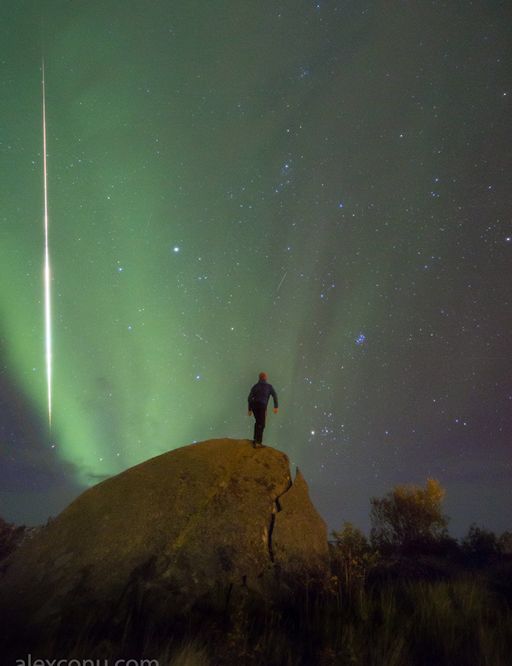
photo Alex Conu
For comparison, the fireball was about as bright as the crescent Moon. "There was a bit of fragmenting towards the end," says Conu. "Very beautiful."
The fireball won't be back on Aug 12th, but the auroras might. Earth is passing through a stream of solar wind filled with negative polarity (-Bz) magnetic fields. Such a solar wind stream can penetrate our planet's magnetic defenses, sparking geomagnetic storms and auroras.
Bron: http://www.spaceweather.com/ | Gewijzigd: 31 januari 2017, 15:35 uur, door Joyce.s
Kans op aurora's 20 september; G1 klasse storm
Aurora's afkomstig van een coronaal gat, snelheden van 550 km/s - 600 km/s
A broad hole has opened up in the sun's atmosphere, and it is spewing a stream of solar wind into space. NASA's Solar Dynamics Observatory is monitoring the structure as it turns toward Earth: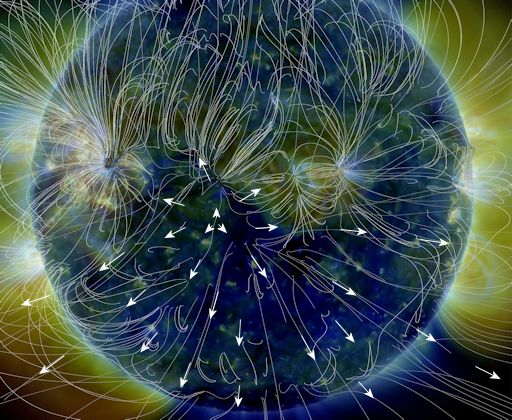
Astronomers call this a "coronal hole." It is a region in the sun's outer atmosphere (corona) where magnetic fields have opened up, allowing solar wind to escape. About a week ago, a stream of solar wind flowing from this coronal hole blew past NASA's STEREO-A spacecraft at 550 km/s to 600 km/s. We can expect similar speeds when it reaches Earth on Sept. 20th, with a 30% chance of G1-classgeomagnetic storms.
Around the Arctic Circle, green lights are already flickering. Yuichi Takasaka saw them Saturday over the Jökulsárlón Glacier Lagoon in Iceland:
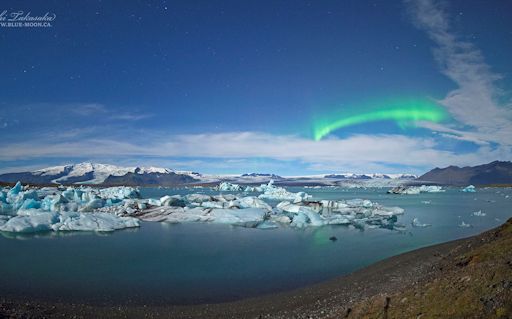
Scientists have long known that equinoxes favor auroras. Around this time of year, even a slight gust of solar wind can spark beautiful Arctic lights. The timing of the incoming solar wind stream, arriving only two days before the northern autumnal equinox, could scarcely be better.
Bron: http://www.spaceweather.com/
Optische illusie, maar een prachtige foto:
On Sept. 15th, something strange happened to the setting sun in Denmark. "It was extremely spectacular (and more than a little weird)," says Liselotte Kahns who took this picture from Nr. Lyngby, Northern Jutland: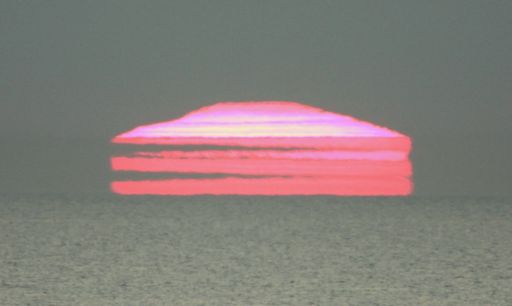
photo Liselotte Kahns
What turned the sun into a stack of hot pancakes? Atmospheric optics expert Les Cowley explains:
"This sunset is a powerful example of 'light ray channelling,'" he says. "Rays from the setting sun get trapped between strong temperature inversion layers, warm air above cold. Their temperature gradients bounce the rays up and down like a waveguide forcing them to travel tens and sometimes even hundreds of miles around Earth's circumference. The rays escape to form multiple slit-like sun images. This mirage's extreme form is the Novaya Zemlya effect when a rectangular sun-stack shows long before true dawn or after sunset."
Bron: http://www.spaceweather.com/
| Gewijzigd: 31 januari 2017, 15:35 uur, door Joyce.s
Aurora's in combinatie met een maanboog
As predicted, Earth is entering a stream of solar wind on Sept. 20th, and this is sparking G1-class geomagnetic storms around the Arctic Circle. Jónína Óskarsdóttir photographed the light show from Faskrudsfjordur, Iceland. Note, however, that there's more than auroras in Óskarsdóttir's shot. "I also saw a moonbow!" she says.

"This is the first time in my life I've seen a moonbow," says Óskarsdóttir. "It made me extremely happy."
A moonbow differs from a common rainbow in only one way: it is created by the Moon rather than the sun. Moonbeams bouncing in and out of falling raindrops are broken into their primary colors, spread into an arc across the sky. The source of the raindrops in Óskarsdóttir's photo is clear: "It was partly cloudy," she says, "and I was glad to be able to see the auroras in between the rainclouds."
More auroras are in the offing tonight as Earth moves deeper into the solar wind stream.
Bron: http://www.spaceweather.com/
Aurora's Greenland
A fast-moving stream of solar wind is buffeting Earth's magnetic field. In response, auroras are dancing around the Arctic Circle. "The magnetic storm hit us as expected [on Sept.20th]!" reports Rayann Elzein from the UNESCO Ilulissat Icefjord World Heritage site in Greenland. "We had such an amazing show!"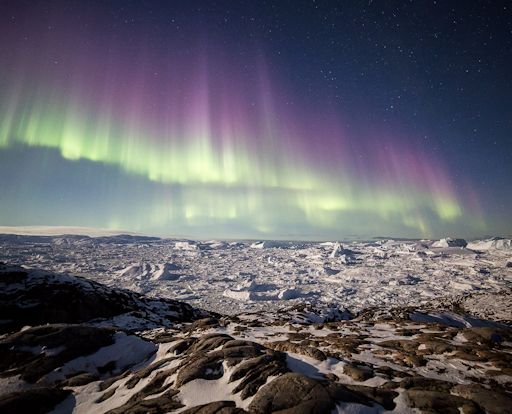
photo Rayann Elzein
"Imagine the icebergs calving in the background and hearing some whales going about in the sea around the fjord with a huge corona forming above our heads!" describes Elzein. "The bright moon was a superb addition to the magic."
He also photographed a surprising splash of red among the green. "We could not dream for a better background," he says.
More auroras are possible tonight as Earth as the solar wind continues to blow.
Bron: http://www.spaceweather.com/

http://services.swpc.noaa.gov/images/planetary-k-index.gif
| Gewijzigd: 31 januari 2017, 15:36 uur, door Joyce.s

 Uitbarstingen van de zon en aurora borealis
Uitbarstingen van de zon en aurora borealis





